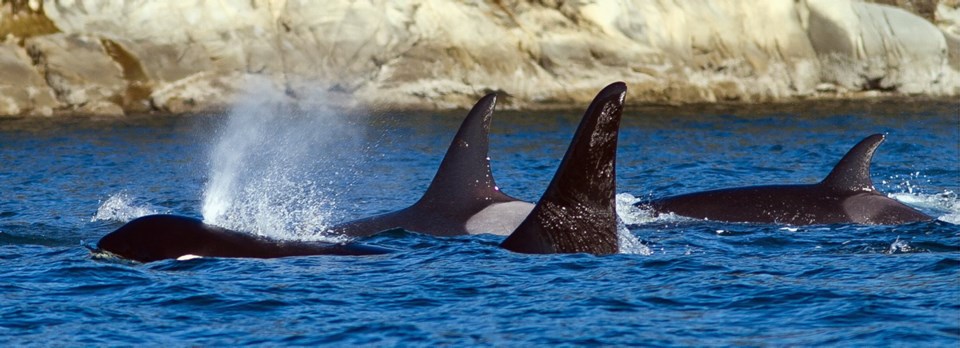Vancouver Island’s sports fishing sector and chambers of commerce leaders are calling on the federal government to hold off on further fishing restrictions and pay attention to their voices as efforts are rolled out to save endangered orcas.
“As British Columbians who are now concerned about the survival of our own businesses and communities, we urge the federal government to slow down the implementation of any additional management measures, take time to get the science right and engage coastal stakeholders,” Karl Ablack, Port Renfrew Chamber of Commerce vice-president, said at a press conference in Esquimalt on Thursday.
Sports fishing representatives said they suffered after closures went into effect this spring off Sooke, in what is part of a larger area deemed to be a critical habitat zone for the 74 remaining southern resident orcas.
Chinook salmon are not only the favourite food of those orcas, but are prized by fishermen.
Industry fears that additional fishing closures could be introduced now that the critical habitat zone has been extended by 5,025 square kilometres off southwestern Vancouver Island.
The zone now stretches just north of Ucluelet and out to sea by 60 kilometres to include Swiftsure and La Perouse banks, popular sports fishing areas. The zone runs from the Southern Gulf Islands and through Juan de Fuca Strait and is outlined in federal Fisheries and Ocean’s updated killer whale recovery strategy released Wednesday,
Val Litwin, B.C. Chamber of Commerce president, said marine-based tourism sustains coastal communities, who are worried about their future. Tourism, sports fishing and the chambers have banded together to form a group called Thriving Orcas, Thriving Coastal Communities.
The group’s recommendations include calling for more research, setting up a multi-sector advisory group for the critical-habitat zones and establishing special management zones.
Members “want desperately to reverse the trend of declining southern resident killer whale populations and they see themselves as partners in the solution,” Litwin said. Increasing the size of the critical habitat zone “sets the stage for additional management measures that could curtail important marine-based tourism activities around La Perouse and Swiftsure banks, areas on which several Island communities depend,” Litwin said.
Recreational fishing brings in direct revenues of close to $1 billion annually in B.C. and provides 8,400 jobs, he said, predicting that about one-third of that could be lost on the Island if fishing closures are imposed.
Ablack said that Port Renfrew, once forestry based, is reinventing itself through recreation and tourism. “The strength of our local economy is now based and primarily dependent upon our anchor industry, which is the sport and recreational fishing industry.”
Ryan Chamberland, Vancouver Island Lodge owner and Sooke Regional Tourism Association president, said the federal government did not listen to the sports fishing sector. “I question the science that the government is using. From the local operators’ perspective, there’s major gaps.”
Their group understands that there needs to be better science, education, and avoidance protocols to allow orcas to feed and properly socialize, he said.
“The people that operate regularly in these areas know that there is room for both of us in our coastal waters.”
Scott Wallace, David Suzuki Foundation senior research scientist, said there is a distinction between an area being identified as important to killer whales and the introduction of closures, which have not been announced.
“The critical habitat identification is firstly a biological recognition of the most important area [to killer whales]. It is not a management measure in itself.
“It was only last year where there were some fishing closures put into place and only for a small part of the area [off Sooke].”
Restrictions on fishing for chinook are needed because many populations are at risk, he said. A new report from the Committee on the Status of Endangered Wildlife in Canada, an advisory group to the Department of Environment and Climate Change, said 13 of 16 Fraser River-bound chinook populations are at risk.
“There needs to be a change in fisheries management regardless,” he said. “The fishing has to racheted down to meet the levels the stocks are at.”
As for the industry’s group’s questions about science, Wallace said, “There is enough science to take precautionary measures.”



